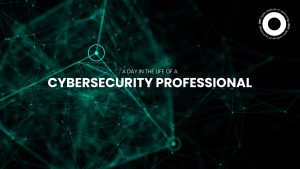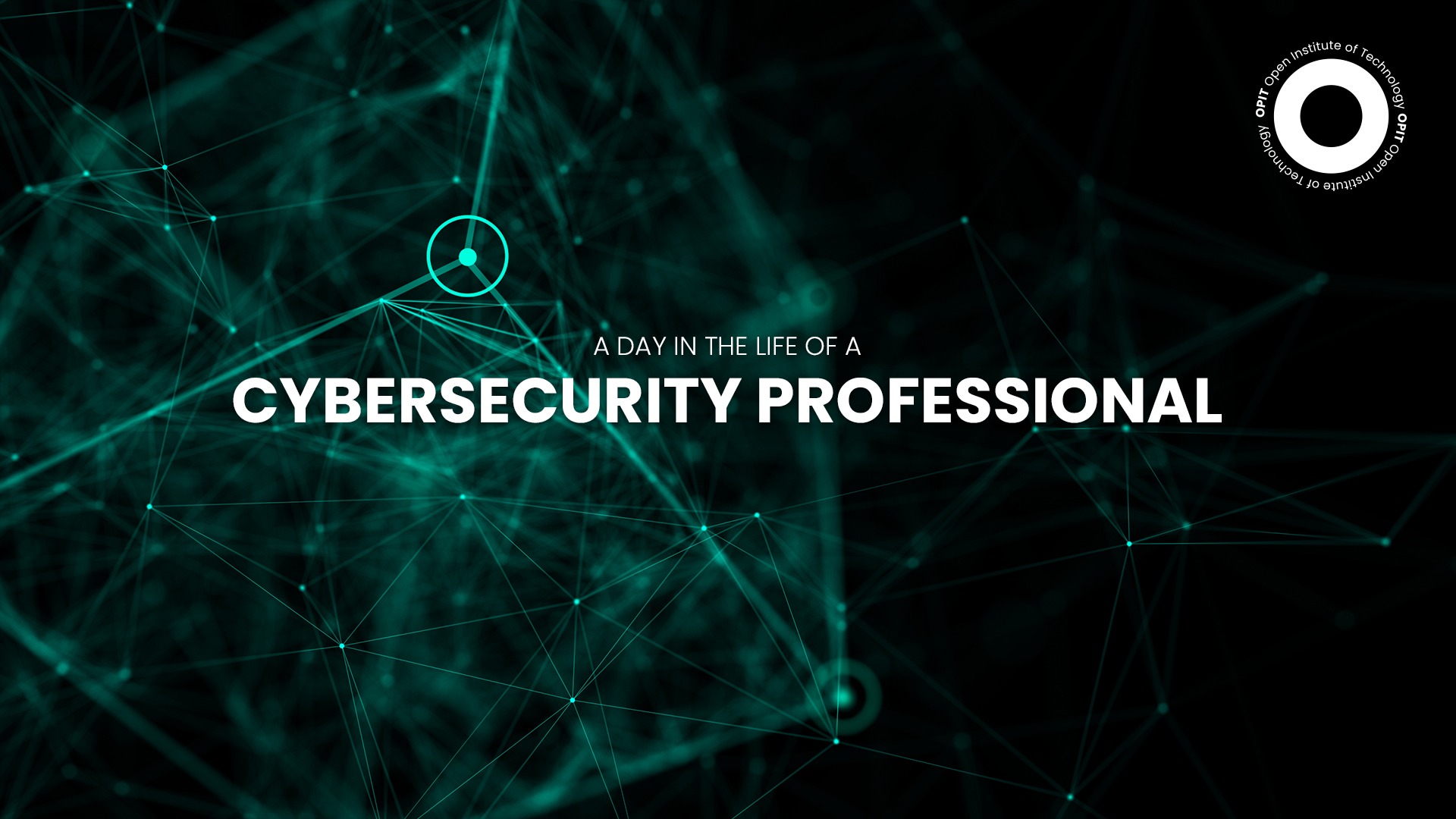

What does an average day look like for somebody working in cybersecurity?
That isn’t an easy question to answer when you consider the vastness of the field. Somebody who works in cybersecurity needs to stay constantly abreast of industry changes – especially new attacks cooked up by cybercriminals – and help their employers create and tweak their security plans.
However, thanks to Tom , who has developed the Open Institute of Technology’s (OPIT’s) Master’s Degree in Enterprise Cybersecurity, we can provide some insight into what your average day may look like.
Who Is Tom ?
Serving as the Program Chair of OPIT’s upcoming Master’s Degree in Cybersecurity, Tom brings a vast amount of practical experience to the table. His work has spanned the globe. Tom has been employed as the Chief Security Officer for a major Croatian bank, in addition to serving as the Chief Information Officer for a company in the United States’ manufacturing sector.
His practical experience spans other industries – including technology and finance – and he’s currently completing a doctorate while running his own practice. Tom’s specialty is the behavioral aspect of cybersecurity. His deep understanding of the “culture” that surrounds the field has been shaped by his work on development strategies, policies, and frameworks for his past employers.
The Importance of Trends
The first thing Tom highlights is that a cybersecurity professional has to follow the trends in the industry. As he points out: “We are living in an era where digital transformation is accelerating, and with it, the complexity and frequency of cyber threats are also increasing.” To demonstrate this, he points to an ISACA report published in 2023 showing that cyber attacks have increased 48% in 2023 compared to 2022. More worryingly, 62% of the organizations that experience these attacks underreport them – an indication that many simply don’t have the talent to truly understand the threat they face.
As a cybersecurity professional, your role is to provide the expertise such companies are sorely lacking.
Thankfully, many business leaders understand that they need this expertise. Tom points out that 59% of leaders say they’re understaffed in the cyber department, leading to a rising demand for people with the following technical skills:
- Identity and access management
- Data protection
- Cloud computing
- DevSecOps (development, security, and operations)
Furthermore, Tom says that artificial intelligence (AI) is completely transforming the cybersecurity industry. While AI is often beneficial to professionals in the field – it can enhance threat detection and response – it is also a danger. Malicious entities can use AI to conduct a new wave of attacks, such as data poisoning, for which you need to be prepared as a cybersecurity professional.
Tom’s discussion of these emerging trends highlights one of the most critical aspects of a day in the life of a cybersecurity professional – learning is key. There is no such thing as static knowledge because the industry (and the attacks your company may face) constantly evolve.
An Average Day Broken Down
Now that you understand how important staying on top of the ever-changing trends in cybersecurity is for those in the field, it’s possible to break things down a little further. On an average day, you may find yourself working on any, some, or even all of the following tasks.
Developing and Maintaining a Cybersecurity Strategy
Given that such a large number of business leaders are understaffed and have minimal access to appropriate talent, you’ll often be tasked with creating and maintaining a company’s cybersecurity strategy.
This strategy is not as simple as creating a collection of actions to take in the event of an attack.
Tom emphasizes not only the importance of proactivity, but also of integrating a cybersecurity strategy into the wider business strategy. “It becomes part of the mission and vision,” he says. “After all, there are two things that are important to companies – their data and customer trust. If you lose customer trust, you lose your business. If you lose your data, you lose your business.”
As a technically adept professional, you’ll be tasked with building a strategy that grows ever more complex as the threats the company faces become more advanced. New technologies – such as AI and machine learning – will be used against you, with your main task being to ensure the strategy you create can fend off such technologically-empowered attacks.
The Simpler Day-to-Day
Now, let’s move away from the complexities of developing an overarching plan and go into more detail about daily responsibilities. A cybersecurity professional is usually tasked with dealing with the day-to-day maintenance of systems.
It’s all about control.
Tom says that much of the role involves proactively identifying new protective measures. For instance, software patching is key – outdated software has vulnerabilities that a hacker can exploit. You’ll need to stay up to date on the development of patches for the software your company uses and, crucially, implement those patches as soon as they’re available.
Creating regular backups is also part of this day-to-day work. It’s an area that many businesses neglect – perhaps assuming that nothing bad can happen to them – but a backup will be a lifesaver if a hacker compromises your company’s main data stores.
Tending to Your Ecosystem
It’s not simply your own institution that you must maintain as a cybersecurity professional – everyone who interacts with that institution must also be managed. Vendors, external software developers, and any other part of your supply chain need to be as risk-aware as your business. As Tom puts it: “If they don’t care about vulnerabilities in their system, and they work for you as a company, then you’ll have an issue because their risk suddenly becomes your risk.”
As such, managing the cyber security aspect of your company’s relationships with its partners is a vital part of your duties. You may engage in planning with those partners, helping them improve their practices, or cooperate with them to create strategies encompassing your entire supply chain.
Continued Education
Tom goes on to highlight just how important continued education is to the success of a cybersecurity professional. “It’s always interesting. And if you’re really passionate about it, cybersecurity becomes your lifestyle,” he says. “You want to see what’s new. What are the new attack methods, what are your competitors doing, and what is new on the market.”
He points to a simple example – phishing emails.
These emails – which were traditionally laden with spelling errors that made them easier to spot – are becoming increasingly hard to detect thanks to the use of AI. They’re written better. Failure to understand and adapt to that fact could make it harder to educate yourself and the people in your company.
Your average day may also involve educating your colleagues about upcoming threats and new attack methods they need to understand. The phishing example Tom shares applies here. Any email that looks somewhat legitimate is a threat, so continued education of your colleagues is essential to stop that threat from having its intended effect.
An Example of a Typical Project
Given how vast the cybersecurity field is, the range of projects you may work on will vary enormously. However, Tom provides an example of when he worked in the banking industry and saw the rise of the Zeus Botnet.
In this case, his responsibilities were twofold.
First – finding a way to defend against botnet attacks. That involved researching the malware to figure out how it spread, allowing him to put protective measures in place to prevent that spread. The second task involved creating educational programs, both for employees and his bank’s clients, to make them aware of the Zeus Botnet.
Here, we see the education part of the cybersecurity professional’s “average day” coming into play, complementing the more technical aspects of dealing with malware. We even see supply chain risk coming into play – each client is part of the bank’s supply chain, meaning they need to understand how to defend themselves just as much as the bank does.
The Qualifications Needed to Work in Cybersecurity
With a multitude of cybersecurity qualifications available – many covering specific niches – it’s tough to find the appropriate one to make you attractive to an employer. That’s where Tom’s work with OPIT comes in. The master’s degree that he’s developing not only focuses on the technical skills a professional needs but places those skills in a business context.
The upcoming course will offer electives in subjects such as AI, cloud security, and IoT security, granting students flexibility to pursue a specialization within their degree. The overall program is also closely aligned to industry certifications – such as those offered by CISSP – to ensure graduates are as industry-ready as they are academically qualified.
The intention, Tom says, is to fill the skills gap that 3 million businesses say they have in cybersecurity. The program provides the right blend of knowledge between technical and managerial skills, in addition to allowing students to pursue subjects of particular interest to them.
Ultimately, it doesn’t teach absolutely everything that you could learn about the industry. No course can. But it does equip you with key foundational knowledge aligned with industry certifications that make you more employable. That, combined with your continued education and completion of relevant certifications once you’re employed, means you have an enormous opportunity to build a successful cybersecurity career with OPIT.
So, the qualifications needed for the industry start with a relevant degree. They then blossom out. Professionals focus on courses that meet the specific requirements of their roles so that they learn the cybersecurity techniques that are most effective for their needs.
Related posts

Source:
- Agenda Digitale, published on November 25th, 2025
In recent years, the word ” sustainability ” has become a firm fixture in the corporate lexicon. However, simply “doing no harm” is no longer enough: the climate crisis , social inequalities , and the erosion of natural resources require a change of pace. This is where the net-positive paradigm comes in , a model that isn’t content to simply reduce negative impacts, but aims to generate more social and environmental value than is consumed.
This isn’t about philanthropy, nor is it about reputational makeovers: net-positive is a strategic approach that intertwines economics, technology, and corporate culture. Within this framework, digitalization becomes an essential lever, capable of enabling regenerative models through circular platforms and exponential technologies.
Blockchain, AI, and IoT: The Technological Triad of Regeneration
Blockchain, Artificial Intelligence, and the Internet of Things represent the technological triad that makes this paradigm shift possible. Each addresses a critical point in regeneration.
Blockchain guarantees the traceability of material flows and product life cycles, allowing a regenerated dress or a bottle collected at sea to tell their story in a transparent and verifiable way.
Artificial Intelligence optimizes recovery and redistribution chains, predicting supply and demand, reducing waste and improving the efficiency of circular processes .
Finally, IoT enables real-time monitoring, from sensors installed at recycling plants to sharing mobility platforms, returning granular data for quick, informed decisions.
These integrated technologies allow us to move beyond linear vision and enable systems in which value is continuously regenerated.
New business models: from product-as-a-service to incentive tokens
Digital regeneration is n’t limited to the technological dimension; it’s redefining business models. More and more companies are adopting product-as-a-service approaches , transforming goods into services: from technical clothing rentals to pay-per-use for industrial machinery. This approach reduces resource consumption and encourages modular design, designed for reuse.
At the same time, circular marketplaces create ecosystems where materials, components, and products find new life. No longer waste, but input for other production processes. The logic of scarcity is overturned in an economy of regenerated abundance.
To complete the picture, incentive tokens — digital tools that reward virtuous behavior, from collecting plastic from the sea to reusing used clothing — activate global communities and catalyze private capital for regeneration.
Measuring Impact: Integrated Metrics for Net-Positiveness
One of the main obstacles to the widespread adoption of net-positive models is the difficulty of measuring their impact. Traditional profit-focused accounting systems are not enough. They need to be combined with integrated metrics that combine ESG and ROI, such as impact-weighted accounting or innovative indicators like lifetime carbon savings.
In this way, companies can validate the scalability of their models and attract investors who are increasingly attentive to financial returns that go hand in hand with social and environmental returns.
Case studies: RePlanet Energy, RIFO, and Ogyre
Concrete examples demonstrate how the combination of circular platforms and exponential technologies can generate real value. RePlanet Energy has defined its Massive Transformative Purpose as “Enabling Regeneration” and is now providing sustainable energy to Nigerian schools and hospitals, thanks in part to transparent blockchain-based supply chains and the active contribution of employees. RIFO, a Tuscan circular fashion brand, regenerates textile waste into new clothing, supporting local artisans and promoting workplace inclusion, with transparency in the production process as a distinctive feature and driver of loyalty. Ogyre incentivizes fishermen to collect plastic during their fishing trips; the recovered material is digitally tracked and transformed into new products, while the global community participates through tokens and environmental compensation programs.
These cases demonstrate how regeneration and profitability are not contradictory, but can actually feed off each other, strengthening the competitiveness of businesses.
From Net Zero to Net Positive: The Role of Massive Transformative Purpose
The crucial point lies in the distinction between sustainability and regeneration. The former aims for net zero, that is, reducing the impact until it is completely neutralized. The latter goes further, aiming for a net positive, capable of giving back more than it consumes.
This shift in perspective requires a strong Massive Transformative Purpose: an inspiring and shared goal that guides strategic choices, preventing technology from becoming a sterile end. Without this level of intentionality, even the most advanced tools risk turning into gadgets with no impact.
Regenerating business also means regenerating skills to train a new generation of professionals capable not only of using technologies but also of directing them towards regenerative business models. From this perspective, training becomes the first step in a transformation that is simultaneously cultural, economic, and social.
The Regenerative Future: Technology, Skills, and Shared Value
Digital regeneration is not an abstract concept, but a concrete practice already being tested by companies in Europe and around the world. It’s an opportunity for businesses to redefine their role, moving from mere economic operators to drivers of net-positive value for society and the environment.
The combination of blockchain, AI, and IoT with circular product-as-a-service models, marketplaces, and incentive tokens can enable scalable and sustainable regenerative ecosystems. The future of business isn’t just measured in terms of margins, but in the ability to leave the world better than we found it.

Source:
- Raconteur, published on November 06th, 2025
Many firms have conducted successful Artificial Intelligence (AI) pilot projects, but scaling them across departments and workflows remains a challenge. Inference costs, data silos, talent gaps and poor alignment with business strategy are just some of the issues that leave organisations trapped in pilot purgatory. This inability to scale successful experiments means AI’s potential for improving enterprise efficiency, decision-making and innovation isn’t fully realised. So what’s the solution?
Although it’s not a magic bullet, an AI operating model is really the foundation for scaling pilot projects up to enterprise-wide deployments. Essentially it’s a structured framework that defines how the organisation develops, deploys and governs AI. By bringing together infrastructure, data, people, and governance in a flexible and secure way, it ensures that AI delivers value at scale while remaining ethical and compliant.
“A successful AI proof-of-concept is like building a single race car that can go fast,” says Professor Yu Xiong, chair of business analytics at the UK-based Surrey Business School. “An efficient AI technology operations model, however, is the entire system – the processes, tools, and team structures – for continuously manufacturing, maintaining, and safely operating an entire fleet of cars.”
But while the importance of this framework is clear, how should enterprises establish and embed it?
“It begins with a clear strategy that defines objectives, desired outcomes, and measurable success criteria, such as model performance, bias detection, and regulatory compliance metrics,” says Professor Azadeh Haratiannezhadi, co-founder of generative AI company Taktify and professor of generative AI in cybersecurity at OPIT – the Open Institute of Technology.
Platforms, tools and MLOps pipelines that enable models to be deployed, monitored and scaled in a safe and efficient way are also essential in practical terms.
“Tools and infrastructure must also be selected with transparency, cost, and governance in mind,” says Efrain Ruh, continental chief technology officer for Europe at Digitate. “Crucially, organisations need to continuously monitor the evolving AI landscape and adapt their models to new capabilities and market offerings.”
An open approach
The most effective AI operating models are also founded on openness, interoperability and modularity. Open source platforms and tools provide greater control over data, deployment environments and costs, for example. These characteristics can help enterprises to avoid vendor lock-in, successfully align AI to business culture and values, and embed it safely into cross-department workflows.
“Modularity and platformisation…avoids building isolated ‘silos’ for each project,” explains professor Xiong. “Instead, it provides a shared, reusable ‘AI platform’ that integrates toolchains for data preparation, model training, deployment, monitoring, and retraining. This drastically improves efficiency and reduces the cost of redundant work.”
A strong data strategy is equally vital for ensuring high-quality performance and reducing bias. Ideally, the AI operating model should be cloud and LLM agnostic too.
“This allows organisations to coordinate and orchestrate AI agents from various sources, whether that’s internal or 3rd party,” says Babak Hodjat, global chief technology officer of AI at Cognizant. “The interoperability also means businesses can adopt an agile iterative process for AI projects that is guided by measuring efficiency, productivity, and quality gains, while guaranteeing trust and safety are built into all elements of design and implementation.”
A robust AI operating model should feature clear objectives for compliance, security and data privacy, as well as accountability structures. Richard Corbridge, chief information officer of Segro, advises organisations to: “Start small with well-scoped pilots that solve real pain points, then bake in repeatable patterns, data contracts, test harnesses, explainability checks and rollback plans, so learning can be scaled without multiplying risk. If you don’t codify how models are approved, deployed, monitored and retired, you won’t get past pilot purgatory.”
Of course, technology alone can’t drive successful AI adoption at scale: the right skills and culture are also essential for embedding AI across the enterprise.
“Multidisciplinary teams that combine technical expertise in AI, security, and governance with deep business knowledge create a foundation for sustainable adoption,” says Professor Haratiannezhadi. “Ongoing training ensures staff acquire advanced AI skills while understanding associated risks and responsibilities.”
Ultimately, an AI operating model is the playbook that enables an enterprise to use AI responsibly and effectively at scale. By drawing together governance, technological infrastructure, cultural change and open collaboration, it supports the shift from isolated experiments to the kind of sustainable AI capability that can drive competitive advantage.
In other words, it’s the foundation for turning ambition into reality, and finally escaping pilot purgatory for good.
Have questions?
Visit our FAQ page or get in touch with us!
Write us at +39 335 576 0263
Get in touch at hello@opit.com
Talk to one of our Study Advisors
We are international
We can speak in:


